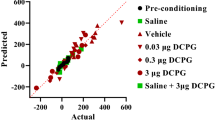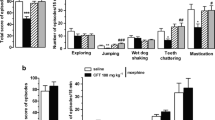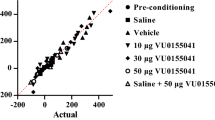Abstract
Objective
It is well established that glutamate and its receptors, particularly the N-methyl-D-aspartate receptor (NMDAR), play a significant role in addiction and that the inhibition of glutamatergic hyperfunction reduces addictive behaviors in experimental animals. Specifically, NMDAR antagonists such as MK-801, and an inducer of the expression of glutamate transporter subtype-1 (GLT-1) (ceftriaxone) are known to inhibit addictive behavior. The purpose of this study was to determine whether the combined action of a low dose of MK-801 and a low dose of ceftriaxone provides better inhibition of the acquisition, extinction, and reinstatement of morphine-induced conditioned place preference (CPP) than either compound alone.
Methods
A morphine-paired CPP experiment was used to study the effects of low doses of MK-801, ceftriaxone and a combination of both on reward-related memory (acquisition, extinction, and reinstatement of morphine preference) in rats.
Results
A low dose of neither MK-801 (0.05 mg/kg, i.p.) nor ceftriaxone (25 mg/kg, i.p.) alone effectively impaired CPP behaviors. However, when applied in combination, they reduced the acquisition of morphine-induced CPP and completely prevented morphine reinstatement. Their combination also notably impaired the extinction of morphine-induced CPP.
Conclusion
The combined action of a low dose of an NMDAR antagonist (MK-801) and GLT-1 activation by ceftriaxone effectively changed different phases of CPP behavior.
Similar content being viewed by others
References
Feil J, Sheppard D, Fitzgerald PB, Yücel M, Lubman DI, Bradshaw JL. Addiction, compulsive drug seeking, and the role of frontostriatal mechanisms in regulating inhibitory control. Neurosci Biobehav Rev 2010, 35: 248–275.
Reichel CM, Bevins RA. Forced abstinence model of relapse to study pharmacological treatments of substance use disorder. Curr Drug Abuse Rev 2009, 2: 184–194.
Wright JW, Harding JW. Contributions of matrix metalloproteinases to neural plasticity, habituation, associative learning and drug addiction. Neural Plast 2009, 2009: 579382.
See RE. Neural substrates of cocaine-cue associations that trigger relapse. Eur J Pharmacol 2005, 526: 140–146.
Shoblock JR, Wichmann J, Maidment NT. The effect of a systemically active ORL-1 agonist, Ro 64-6198, on the acquisition, expression, extinction, and reinstatement of morphine conditioned place preference. Neuropharmacology 2005, 49: 439–446.
McFarland K, Lapish CC, Kalivas PW. Prefrontal glutamate release into the core of the nucleus accumbens mediates cocaine-induced reinstatement of drug-seeking behavior. J Neurosci 2003, 23: 3531–3537.
Vanderschuren LJ, Schoffelmeer AN, De Vries TJ. Does dizocilpine (MK-801) inhibit the development of morphine-induced behavioural sensitization in rats? Life Sci 1997, 61: PL427–433.
Kim HS, Jang CG, Park WK. Inhibition by MK-801 of morphineinduced conditioned place preference and postsynaptic dopamine receptor supersensitivity in mice. Pharmacol Biochem Behav 1996, 55: 11–17.
Miller BR, Dorner JL, Shou M, Sari Y, Barton SJ, Sengelaub DR, et al. Up-regulation of GLT1 expression increases glutamate uptake and attenuates the Huntington’s disease phenotype in the R6/2 mouse. Neuroscience 2008, 153: 329–337.
Sari Y, Smith KD, Ali PK, Rebec GV. Upregulation of GLT1 attenuates cue-induced reinstatement of cocaine-seeking behavior in rats. J Neurosci 2009, 29: 9239–9243.
Ward SJ, Rasmussen BA, Corley G, Henry C, Kim JK, Walker EA, et al. Beta-lactam antibiotic decreases acquisition of and motivation to respond for cocaine, but not sweet food, in C57Bl/6 mice. Behav Pharmacol 2011, 22: 370–373.
Ma YY, Chu NN, Guo CY, Han JS, Cui CL. NR2B-containing NMDA receptor is required for morphine-but not stress-induced reinstatement. Exp Neurol 2007, 203: 309–319.
Görgülü A, Kiris T, Unal F, Türkoğlu U, Küçük M, Cobanoğlu S. Protective effect of the N-methyl-D-aspartate receptor antagonists, MK-801 and CPP on cold-induced brain oedema. Acta Neurochir (Wien) 1999, 141: 93–98.
Sekizawa S, Bechtold AG, Tham RC, Bonham AC. A novel postsynaptic group II metabotropic glutamate receptor role in modulating baroreceptor signal transmission. J Neurosci 2009, 29: 11807–11816.
Panos JJ, Rademacher DJ, Renner SL, Steinpreis RE. The rewarding properties of NMDA and MK-801 (dizocilpine) as indexed by the conditioned place preference paradigm. Pharmacol Biochem Behav 1999, 64: 591–595.
Sondheimer I, Knackstedt LA. Ceftriaxone prevents the induction of cocaine sensitization and produces enduring attenuation of cue- and cocaine-primed reinstatement of cocaine-seeking. Behav Brain Res 2011, 225: 252–258.
Zhang J, Tan H, Niu HC, Wang JH, Tang XD, Sanford LD, et al. Pentylenetetrazole-induced status epilepticus following training does not impair expression of morphine-induced conditioned place preference. Addict Biol 2009, 14: 174–184.
Johnson SW, North RA. Opioids excite dopamine neurons by hyperpolarization of local interneurons. J Neurosci 1992, 12: 483–488.
Kalivas PW, Alesdatter JE. Involvement of N-methyl-D-aspartate receptor stimulation in the ventral tegmental area and amygdala in behavioral sensitization to cocaine. J Pharmacol Exp Ther 1993, 267: 486–495.
Prieto-Gomez B, Vazquez-Alvarez AM, Martinez-Pena JL, Reyes-Vazquez C, Yang PB, Dafny N. Methylphenidate and amphetamine modulate differently the NMDA and AMPA glutamatergic transmission of dopaminergic neurons in the ventral tegmental area. Life Sci 2005, 77: 635–649.
Harris GC, Wimmer M, Byrne R, Aston-Jones G. Glutamateassociated plasticity in the ventral tegmental area is necessary for conditioning environmental stimuli with morphine. Neuroscience 2004, 129: 841–847.
Kalivas PW, Lalumiere RT, Knackstedt L, Shen H. Glutamate transmission in addiction. Neuropharmacology 2009, 56(Suppl 1): 169–173.
Li F, Wang XS, Dai RP, Zhang JY, Zhou XF, Hao W, et al. The activation of NMDA receptor-ERK pathway in the central amygdala is required for the expression of morphine-conditioned place preference in the rat. Neurotox Res 2011, 20: 362–371.
Rawls SM, Baron DA, Kim J. beta-Lactam antibiotic inhibits development of morphine physical dependence in rats. Behav Pharmacol 2010, 21: 161–164.
Lee H, Kim JJ. Amygdalar NMDA receptors are critical for new fear learning in previously fear-conditioned rats. J Neurosci 1998, 18: 8444–8454.
Abel T, Lattal KM. Molecular mechanisms of memory acquisition, consolidation and retrieval. Curr Opin Neurobiol 2001, 11: 180–187.
Author information
Authors and Affiliations
Corresponding authors
Additional information
These authors contributed equally to this work.
Rights and permissions
About this article
Cite this article
Fan, Y., Niu, H., Rizak, J.D. et al. Combined action of MK-801 and ceftriaxone impairs the acquisition and reinstatement of morphine-induced conditioned place preference, and delays morphine extinction in rats. Neurosci. Bull. 28, 567–576 (2012). https://doi.org/10.1007/s12264-012-1269-8
Received:
Accepted:
Published:
Issue Date:
DOI: https://doi.org/10.1007/s12264-012-1269-8




